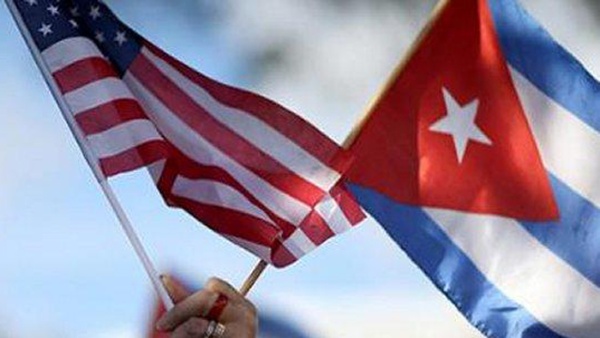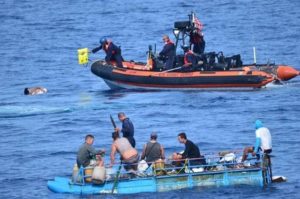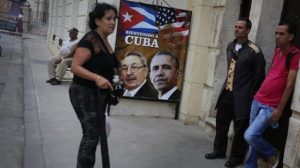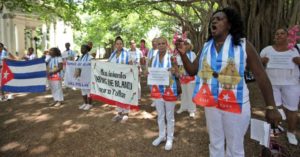The day it was announced the cessation of the “Wet feet, Dry feet” policy (January 12, 2017), there was no celebration in Havana.
This policy, which was considered an appendix of the 1966 Cuban Adjustment Act, was established by Bill Clinton in 1995 during the crisis of the rafters to ensure that Cuban migrants who reach the shores of the United States a legal status and an almost guaranteed way to permanent residency. The terse official announcement of the revolutionary Government, published in the State media announcing the measure, stressed its immediate effect and blamed the law for the death of hundreds of thousands of Cubans who have perished at sea or on the route from Central America.
Rarely the official notes have the tino reflect the State of mind of the streets. And this time was no different. Outside the pages of the newspapers, Havana was living in uncertainty. What would happen to those who paid visas for Mexico or another country of Latin America with the aim of crossing the border in the next few weeks; who gave the finishing touches to the rafts made of polyfoam, boards and outboard motors to cross the sea, and with those who sold their houses and cars seeking to reach the United States? Cuban immigration exception, of such daily, had become a natural state of affairs.
January 12, 2017, eight days before the inauguration of Donald Trump, Barack Obama returned to shake our certainties, as did it for the first time on December 17, 2014. From the political standpoint, in a scenario of normalization of relations between the two countries, the cessation of this policy is consistent with the spirit of the negotiations. There are agreements on energy, environment and health. There is disagreement in the field of human rights. In any case, Cuban migratory exceptionality ceased to be justified after the opening of the embassies in Washington and Havana. Called Castro’s regime remains, eyes us, repressive and totalitarian, but not so much as to not be able to resolve differences through dialogue.
However, it is difficult to ignore the human balance of the cessation of this policy. From 2012, more than 118.000 Cubans have followed the route of the sea or land – or a combination of both – to reach U.S. territory, according to the Department of Homeland Security. The Cubans who now try to reach the country’s North will not be legally admitted or receive alimony, possibilities for study, health insurance or work permit.
It has changed everything out without that nothing will change in. The causes of migration remain immovable, although Cuban newspapers insist on avoiding them. Who came up to the borders of United States January 13 escaped from a regime of political persecution. That touched ground from day 14 flee the lack of economic opportunities. And, for that reason, they are not accepted.
Cuban migration to the Salvadoran is not more politics. Cuban migration to the Salvadoran is also cheaper. But for many years talk about political migration served the US Government to open the door to Cubans and close them to the rest. The law of adjustment, the “dry feet, wet feet” and which offered parole to physicians who met internationalist missions in third countries seemed designed not so much to protect the people as to anger to a Government. Images of the rafters giving back to the world should be ashamed the Government from Havana. Capitalism’s success was measured from the scandalous figure of emigrants which produced the Socialist island. But the wily Cuban Government seized their migrants to improve economy without ceding even a centimeter in its form of exercising power. Reduced them to senders of remittances, tourists who occupied hotels all inclusive, recurrent visitors with stamps in passports which allow to enter systematically into the land of birth, never citizens with right to vote or legally invest in their own country. Either side the emigrant who had feet dry was as currency, as collateral damage of foreign policy.
The migration also served the Cuban Government to quell possible social explosions. The opening of the port of Camarioca provided 260,000 migrants; Mariel, 120,000, and those who have crossed Central America already exceed the 100,000 from 2012. All this without counting the hundreds of thousands of boat people. No one leaves a country where everything is going well. All these episodes cleaned up to the island’s dissidents. But today the dissatisfied are most useful to American policy on land than in the sea, because the subversion of the Cuban system continues to be a goal. Now the US Government seems to wonder what would be able to do peoples when limited see their civil liberties, labor and economic opportunities but they do not have an immigration outlet for their problems.
However, the end of “wet feet, dry feet” policy is not the only variable to a transformation in Cuba. Potential migrants do not become overnight overnight activists.
Change a nation not only depends on the permanence of physical in the territory, but that are created the conditions for active participation in the political life of the country, that the State security bodies do not systematically suppress to those who disagree, of the Government of Washington not subsidize a large part of those who disagree by placing them in an unavoidable situation of political vulnerability There is a plausible alternative policy, which does not negotiate basic principles of the Cuban as the sovereignty, independence and self-determination people and do not sacrifice public achievements of the revolution such as health and education.
These conditions, in the Cuba of 2017, do not yet exist. There will then be Cubans who prefer to share fate with eleven million undocumented – possible low with any Government, no matter whether it is Republican or Democrat – that today there are in the United States, and there will be people who are more involved in the political life of his country, who asks for your account to the island which was atrophied in the desire to and begin the path of change.
Agencies/NYT/Elaine Diaz/Internet Photos/extracts/ Arnoldo Varona / TheCubanHistory.com
THE CUBAN HISTORY, HOLLYWOOD.
FOLLOW US ON TWITTER AND FACEBOOK. THECUBANHISTORY.COM
CUBA Y EEUU: QUE PASARÁ DESPUÉS DEL CESE DE LA POLÍTICA “PIES SECOS, PIES MOJADOS”.
El día que se anunció la terminación de la política “pies secos, pies mojados” (Enero 12, 2017), no hubo celebración en La Habana.
Esta política, considerada un apéndice de la Ley de Ajuste Cubano de 1966, fue establecida por Bill Clinton en 1995 durante la crisis de los balseros para garantizar a los migrantes cubanos que llegaran a las costas de Estados Unidos un estatus legal y un camino casi garantizado a la residencia permanente. El escueto comunicado oficial del gobierno revolucionario publicado en los medios estatales anunciando la medida, recalcó su efecto inmediato y culpó a la ley por la muerte de los cientos de miles de cubanos que han perecido en el mar o en la ruta de Centroamérica.
Rara vez las notas oficiales tienen el tino de reflejar el estado de ánimo de las calles. Y esta vez no fue diferente. Fuera de las páginas de los diarios, La Habana vivía en incertidumbre. ¿Qué iba a pasar con aquellos que pagaron visas para México u otro país de América Latina con el objetivo de cruzar la frontera en las próximas semanas; con quienes daban los toques finales a las balsas hechas de poliespuma, tablas y motores fuera de borda para atravesar el mar, y con los que vendieron sus casas y carros buscando llegar hasta Estados Unidos? La excepción migratoria cubana, de tan cotidiana, se había convertido en un estado natural de las cosas.
El 12 de enero de 2017, ocho días antes de la toma de posesión de Donald Trump, Barack Obama volvía a estremecer nuestras certezas, como lo hizo por primera vez el 17 de diciembre de 2014. Desde el punto de vista político, en un escenario de normalización de las relaciones entre ambos países, el cese de esta política es coherente con el ánimo de las negociaciones. Hay acuerdos sobre energía, medioambiente, salud. Hay desacuerdo en materia de derechos humanos. En todo caso, la excepcionalidad migratoria cubana dejó de justificarse luego de la apertura de las embajadas en Washington y La Habana. El llamado régimen de Castro sigue siendo, a ojos estadounidenses, represivo y totalitario, pero no tanto como para no poder resolver las diferencias a través del diálogo.
No obstante, es difícil obviar el saldo humano del cese de esta política. Desde 2012, más de 118.000 cubanos han seguido la ruta del mar o de la tierra —o alguna combinación de ambas— para alcanzar territorio estadounidense, según el Departamento de Seguridad Nacional. Los cubanos que a partir de ahora intenten llegar al país del norte no serán legalmente admitidos ni recibirán pensiones alimenticias, posibilidades de estudio, seguro médico ni permiso de trabajo.
Ha cambiado todo afuera sin que nada cambie adentro. Las causas de la migración siguen inamovibles, aunque los diarios cubanos insistan en obviarlas. Quienes llegaban hasta las fronteras de Estados Unidos el 13 de enero escapaban de un régimen de persecución política. Los que tocaron tierra a partir del día 14 huyen de la falta de oportunidades económicas. Y, por tal motivo, no serán aceptados.
No es más política la migración cubana que la salvadoreña. Tampoco es más económica la migración cubana que la salvadoreña. Pero durante muchos años hablar de migración política sirvió al gobierno estadounidense para abrir las puertas a cubanos y cerrarlas al resto. La Ley de Ajuste, la de “pies secos, pies mojados” y la que ofrecía parole a los médicos que cumplieran misiones internacionalistas en terceros países parecían diseñadas no tanto para proteger al pueblo como para encolerizar a un gobierno. Las imágenes de los balseros dando la vuelta al mundo debían avergonzar al gobierno de La Habana. El éxito del capitalismo se medía a partir de la escandalosa cifra de emigrantes que producía la isla socialista. Pero el astuto gobierno cubano aprovechó a sus migrantes para mejorar la economía sin ceder ni un centímetro en su forma de ejercer el poder. Los redujo a enviadores de remesas, turistas que ocupaban hoteles todo incluido, visitantes recurrentes con estampas en pasaportes que permiten entrar sistemáticamente a la tierra de nacimiento, nunca ciudadanos con derecho a voto o a invertir legalmente en su propio país. De uno y otro lado el emigrante que tenía los pies secos quedó como moneda de cambio, como daño colateral de la política exterior.
La migración sirvió también al gobierno cubano para aplacar posibles estallidos sociales. La apertura del puerto de Camarioca aportó 260.000 migrantes; Mariel, 120.000, y quienes atraviesan Centroamérica ya superan los 100.000 desde 2012. Todo esto sin contar los cientos de miles de balseros. Nadie abandona un país donde todo marcha bien. Todos estos episodios limpiaron a la isla de inconformes. Pero hoy los inconformes son más útiles a la política estadounidense en tierra que en el mar, porque la subversión del sistema cubano continúa siendo un objetivo. Ahora el gobierno estadounidense parece preguntarse qué serían capaces de hacer los pueblos cuando ven limitadas sus libertades civiles, sus oportunidades laborales y económicas pero no tienen una salida migratoria para sus problemas.
Sin embargo, el fin de la política “pies secos, pies mojados” no es la única variable para una transformación en Cuba. Los posibles migrantes no se convertirán de la noche a la mañana en activistas.
Cambiar una nación no solo depende de la permanencia física en el territorio, sino de que estén creadas las condiciones para la participación activa en la vida política del país, de que los órganos de la seguridad del Estado no repriman sistemáticamente a quienes disienten, de que el gobierno de Washington no subvencione a una buena parte de quienes disienten colocándolos en una inevitable situación de vulnerabilidad política, de que haya una alternativa política plausible, que no negocie principios básicos del pueblo cubano como la soberanía, la independencia, la autodeterminación y no sacrifique conquistas de la Revolución como la salud y la educación públicas.
Esas condiciones, en la Cuba de 2017, todavía no existen. Habrá entonces cubanos que prefieran compartir destino con los once millones de indocumentados —posibles deportables bajo cualquier gobierno, no importa si es republicano o demócrata— que hay hoy en Estados Unidos, y habrá quienes se involucren más en la vida política de su país, quienes le pidan cuentas a la isla que se quedó atrofiada en las ganas e inicien el camino del cambio.
Agencies/NYT/Elaine Diaz/Internet Photos/Extractos/ Arnoldo Varona/ TheCubanHistory.com
THE CUBAN HISTORY, HOLLYWOOD.










